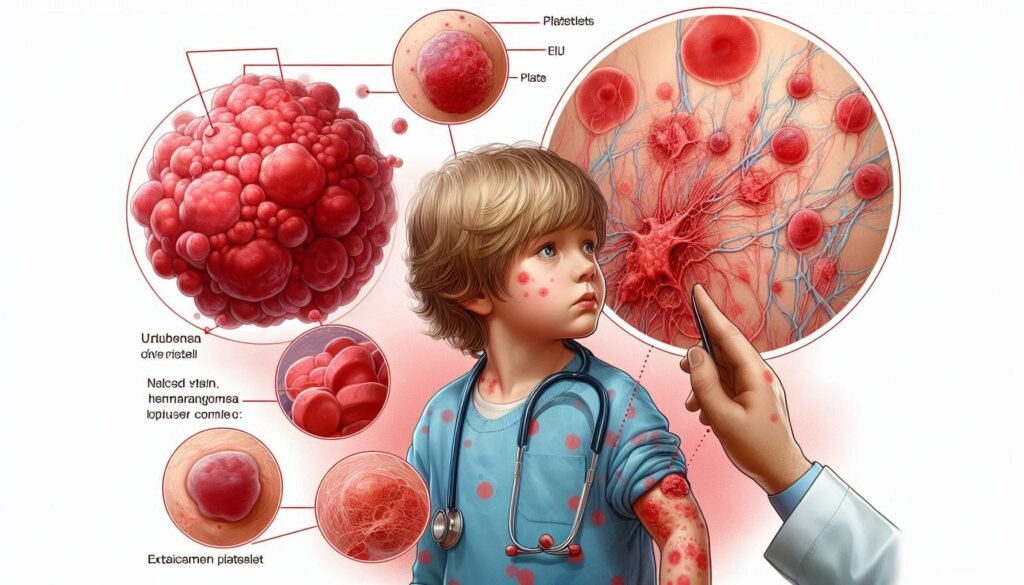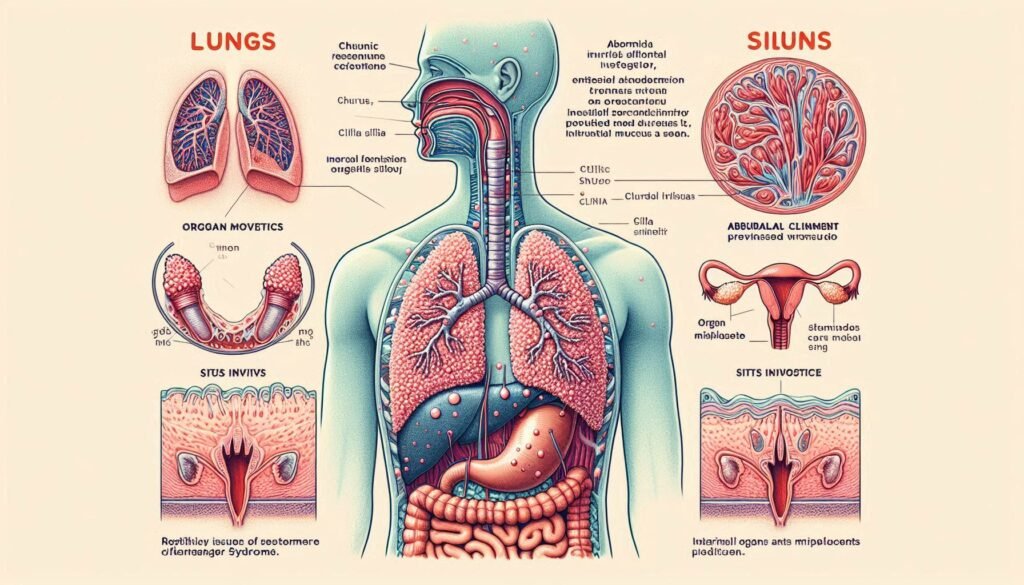Kasabach-Merritt Syndrome (KMS) is a rare but complex vascular disorder that can pose significant challenges for those affected. This syndrome often manifests in infants and young children, leading to serious health complications if not recognized and treated promptly.
Understanding KMS is crucial for parents, caregivers, and healthcare professionals alike. In this blog post, we will explore the intricacies of Kasabach-Merritt Syndrome—its symptoms, diagnosis, treatment options, and the emotional journey faced by families grappling with this condition. Join us as we delve into what you need to know about KMS and its impact on lives around the world.

Kasabach-Merritt Syndrome: An Overview of the Rare Vascular Disorder
Kasabach-Merritt Syndrome is a rare vascular disorder characterized by the presence of large vascular tumors, commonly known as hemangiomas. These tumors can trap platelets in their tissue, leading to severe thrombocytopenia—a dangerously low platelet count.
“What Triggers Guillain-Barré Syndrome? Recovery Guide”
Primarily affecting infants and young children, KMS can result in significant coagulopathy. The symptoms may vary but often include bruising, swelling over the tumor site, and signs of bleeding.
The exact cause remains unclear; however, early diagnosis and intervention are critical for managing this condition effectively. Understanding its complexities can empower families dealing with KMS to seek appropriate medical care promptly.
Historical Perspective: First Description and Evolving Understanding
Kasabach-Merritt Syndrome was first described in the 1940s by Dr. Kasabach and Dr. Merritt, who reported a unique case involving a large hemangioma and significant thrombocytopenia. Their findings highlighted the complex relationship between vascular tumors and blood abnormalities.
Initially thought to be an isolated phenomenon, research over the years revealed that this syndrome is associated with various types of vascular lesions. This evolving understanding shifted focus towards its pathophysiology, emphasizing platelet trapping within these tumors.
“Why Does Ganser Syndrome Cause False Answers?”
As medical knowledge progressed, more cases were documented, allowing for better recognition and management strategies. Today, ongoing research continues to deepen our comprehension of this rare condition’s implications on health outcomes and treatment options.
Pathophysiology: Vascular Tumors and Platelet Trapping
Kasabach-Merritt Syndrome is primarily associated with vascular tumors, often hemangiomas. These lesions can grow rapidly and lead to significant complications. Their size and nature disrupt normal blood flow.
The hallmark of this syndrome is platelet trapping within these tumors. As blood circulates through the lesion, platelets get sequestered in large numbers. This process causes a decrease in circulating platelets, resulting in thrombocytopenia.
“How Does Gaucher’s Syndrome Affect Metabolism?”
Platelet consumption triggers coagulopathy, where the body struggles to form clots effectively. Consequently, patients experience an increased risk of bleeding complications. Understanding this pathophysiology is crucial for managing Kasabach-Merritt Syndrome effectively.
Clinical Presentation: Recognizing the Signs and Symptoms
Kasabach-Merritt Syndrome often presents with a variety of distinct signs and symptoms. Patients may notice a rapidly enlarging vascular tumor, typically located in the skin or soft tissues. These tumors can appear as hemangiomas, characterized by their reddish-blue color.
Another hallmark symptom is thrombocytopenia, which results in easy bruising and prolonged bleeding after minor injuries. Symptoms like petechiae—small red spots from broken capillaries—are also common due to low platelet counts.
“What Is Gerstmann Syndrome? Brain Function Guide”
Additionally, individuals might experience fatigue, weakness, or even episodes of severe pain around the tumor site. Early recognition is crucial for effective management and treatment of this complex condition.
Types of Vascular Tumors Associated with Kasabach-Merritt Syndrome
Kasabach-Merritt Syndrome is closely linked to specific types of vascular tumors. The most common tumor associated with this syndrome is the kaposiform hemangioendothelioma (KHE). KHE typically appears as a reddish-purple lesion and often occurs in infants.
Another type is the infantile hemangioma, which can also lead to significant complications. While many resolve on their own, when they become problematic, they may contribute to thrombocytopenia and coagulopathy seen in Kasabach-Merritt Syndrome.
“Why Does Harlequin Syndrome Affect Sweating? Expert Guide”
Less frequently, other vascular anomalies like lymphatic malformations or angiosarcomas are noted. Each tumor type presents unique challenges for diagnosis and management within this rare syndrome.
Hematological Complications: Thrombocytopenia and Coagulopathy
Hematological complications are significant in Kasabach-Merritt Syndrome. The syndrome often leads to thrombocytopenia, a condition characterized by abnormally low platelet counts. This occurs due to the trapping of platelets within vascular tumors.
“How Does Holt-Oram Syndrome Impact Heart Development?”
Coagulopathy is another critical aspect that patients may face. It involves abnormal blood clotting, which can lead to excessive bleeding or bruising. The interaction between the vascular tumor and the body’s coagulation system creates complex challenges for management.
Monitoring these hematological issues is essential for effective treatment planning. Regular blood tests help assess platelet levels and coagulation factors, guiding healthcare providers in implementing appropriate interventions tailored to each patient’s needs.
Diagnostic Approaches: Imaging Techniques and Laboratory Tests
Diagnosing Kasabach-Merritt Syndrome involves a combination of imaging techniques and laboratory tests. Imaging is essential for visualizing the vascular tumors associated with this condition. Ultrasound, MRI, and CT scans are commonly employed to assess tumor size, location, and involvement of surrounding structures.
Laboratory tests play a crucial role in evaluating blood parameters. A complete blood count (CBC) can reveal thrombocytopenia—a hallmark feature of the syndrome—alongside other coagulopathy indicators.
Additionally, platelet function assays may be performed to further understand the extent of hematological complications. Accurate diagnosis is critical for guiding effective treatment strategies tailored to each patient’s specific needs.
Differential Diagnosis: Distinguishing from Similar Conditions
Differentiating Kasabach-Merritt Syndrome from similar conditions is crucial for effective management. Conditions like infantile hemangiomas can often mimic its symptoms but typically do not present with the same degree of thrombocytopenia.
Other vascular anomalies, such as arteriovenous malformations, may also cause complications resembling those seen in this syndrome. Careful evaluation through imaging and laboratory tests helps clarify the diagnosis.
Additionally, autoimmune disorders, infections, or malignancies could contribute to low platelet counts and coagulopathy. A thorough medical history and clinical examination are essential in distinguishing these overlapping presentations.
Treatment Modalities: Medical Management and Interventional Approaches
Treatment for Kasabach-Merritt Syndrome often starts with medical management. Corticosteroids are commonly used to reduce inflammation and tumor size. These medications help in controlling symptoms and may stabilize the patient’s condition.
Interventional approaches can be considered when medical therapy alone is insufficient. This might include procedures like embolization, which blocks blood flow to the vascular tumor, leading to shrinkage. Such techniques can provide immediate relief from complications associated with the syndrome.
In severe cases, surgical intervention may be necessary. Removing the vascular tumor directly can alleviate pressure on surrounding tissues and improve overall health outcomes for affected individuals. Each treatment plan should be tailored based on individual needs and responses.
Pharmacological Interventions: Corticosteroids and Other Medications
Pharmacological interventions play a crucial role in managing Kasabach-Merritt Syndrome. Corticosteroids are often the first line of treatment due to their ability to reduce inflammation and inhibit tumor growth. They can help stabilize platelets and improve hematologic abnormalities.
Other medications, such as vincristine or interferon-alpha, may also be employed depending on the severity of the case. These drugs target vascular tumors more directly, potentially minimizing complications associated with thrombocytopenia.
In some cases, intravenous immunoglobulin (IVIG) is utilized for its immune-modulating properties. The choice of medication depends on individual patient factors and should always be closely monitored by healthcare professionals for optimal results.
Surgical Options: When and How to Intervene
Surgical intervention for Kasabach-Merritt Syndrome is typically reserved for cases where conservative management fails or complications arise. Surgery may be necessary to remove large vascular tumors that cause significant symptoms, such as pain or functional impairment.
The timing of surgery depends on various factors, including the patient’s overall health and the tumor’s size and location. Surgical options can vary from complete excision to debulking procedures aimed at reducing tumor volume.
Surgeons must carefully assess risks versus benefits before proceeding. Post-surgical monitoring is essential due to potential bleeding or recurrence of the vascular lesion, ensuring timely intervention if complications occur.
Embolization Techniques in Managing Vascular Tumors
Embolization techniques are vital in managing vascular tumors associated with Kasabach-Merritt Syndrome. These minimally invasive procedures aim to occlude blood flow to the tumor, reducing its size and alleviating symptoms.
The procedure involves inserting a catheter into the blood vessel supplying the tumor. Physicians then introduce embolic agents, which can be particles, coils, or glue, effectively blocking blood supply. This approach minimizes bleeding risks and promotes healing.
Patients often experience significant relief after embolization. It can enhance overall treatment effectiveness when combined with other modalities like surgery or medical management. Monitoring post-procedure is crucial for addressing any complications that may arise during recovery.
Monitoring and Managing Complications in Kasabach-Merritt Syndrome
Monitoring complications in Kasabach-Merritt Syndrome is crucial for patient safety. Regular blood tests help assess platelet counts and coagulation profiles, enabling timely interventions. This vigilance can prevent severe bleeding episodes.
Patients often require close observation for signs of vascular tumor growth or changes in symptoms. Imaging studies like ultrasounds or MRIs may be used periodically to evaluate the size and impact of the tumors on surrounding tissues.
Managing complications involves a multidisciplinary approach. Collaboration between hematologists, oncologists, and radiologists ensures comprehensive care tailored to each patient’s needs. Early identification of issues leads to effective treatment strategies, improving outcomes significantly for those affected by this rare disorder.
Prognosis and Long-term Outcomes for Affected Individuals
The prognosis for individuals with Kasabach-Merritt Syndrome can vary significantly. Early diagnosis and prompt treatment are crucial in improving outcomes. Many patients may experience stabilization or even regression of vascular tumors with appropriate management.
However, long-term complications such as chronic thrombocytopenia and coagulopathy may persist. These issues can lead to an increased risk of bleeding, impacting daily activities and overall quality of life.
Regular follow-up care is essential for monitoring health status. Multidisciplinary teams often provide comprehensive support, addressing both physical and psychological needs. With ongoing advancements in treatment options, many affected individuals can lead fulfilling lives despite the challenges associated with this rare vascular disorder.
Pediatric Considerations: Kasabach-Merritt Syndrome in Infants and Children
Kasabach-Merritt Syndrome primarily affects infants and young children, often presenting shortly after birth. The vascular tumors associated with this syndrome can grow rapidly, leading to significant complications. Parents should be vigilant for unusual bruising or swelling.
Diagnosis in pediatric patients typically involves imaging techniques like ultrasound or MRI, alongside blood tests to assess platelet counts. Early identification is crucial as timely intervention can improve outcomes significantly.
Management strategies may differ from adults due to the unique developmental needs of children. A multidisciplinary approach involving pediatricians, hematologists, and oncologists is essential for effective care and support throughout treatment.
Psychological Support for Patients and Families
Living with Kasabach-Merritt Syndrome can be incredibly challenging for both patients and their families. The emotional toll of managing a rare vascular disorder often leads to feelings of anxiety and isolation. Psychological support plays a vital role in helping individuals cope.
Therapies such as cognitive-behavioral therapy (CBT) can provide coping strategies, enabling patients to manage stress more effectively. Support groups also offer valuable connections with others facing similar challenges, fostering a sense of community.
Families are equally affected by the diagnosis and its implications. Family counseling can enhance communication and strengthen bonds while addressing shared concerns about treatment options and long-term outcomes in this complex condition.
Genetic Aspects: Current Understanding and Ongoing Research
Research into the genetic aspects of Kasabach-Merritt Syndrome is still evolving. While the exact genetic causes remain unclear, some studies suggest a connection to mutations in certain genes associated with vascular development.
These genetic factors may influence how vascular tumors form and behave, leading to complications like thrombocytopenia. Understanding these connections can help identify at-risk individuals.
Ongoing research aims to uncover specific genetic markers linked to this syndrome. By identifying these markers, scientists hope to improve diagnosis and tailor treatment strategies for affected patients. As research progresses, new insights could pave the way for targeted interventions that enhance patient outcomes in Kasabach-Merritt Syndrome.
Emerging Therapies: Targeted Treatments and Clinical Trials
Recent advancements in the understanding of Kasabach-Merritt Syndrome have paved the way for innovative therapies. Researchers are currently exploring targeted treatments that aim to inhibit specific pathways involved in vascular tumor growth. These approaches show promise in reducing tumor size and alleviating symptoms.
Clinical trials play a crucial role in assessing these emerging therapies. Patients may gain access to cutting-edge treatments while contributing valuable data to ongoing research efforts. Participation can lead to breakthroughs that enhance care strategies for those with this rare condition.
Additionally, some studies focus on repurposing existing medications known for their efficacy against similar disorders. This strategy accelerates the process of finding effective solutions without starting from scratch.
Living with Kasabach-Merritt Syndrome: Coping Strategies and Quality of Life
Living with Kasabach-Merritt Syndrome poses unique challenges for patients and their families. It’s essential to develop coping strategies that enhance quality of life. Regular follow-ups with healthcare providers can help in managing symptoms effectively.
Support groups offer emotional relief, connecting those affected by the syndrome. Maintaining a healthy lifestyle through balanced nutrition and appropriate physical activity is crucial as well. Stress management techniques like mindfulness or counseling also contribute positively to mental health.
Education about the condition empowers both patients and caregivers, enabling them to make informed decisions about care. By fostering a supportive environment, individuals can navigate daily struggles while focusing on living fulfilling lives despite their diagnosis.


